Glassy phase in the Hamiltonian Mean Field model
基底和膜层-基底系统的赝布儒斯特角计算(英文)
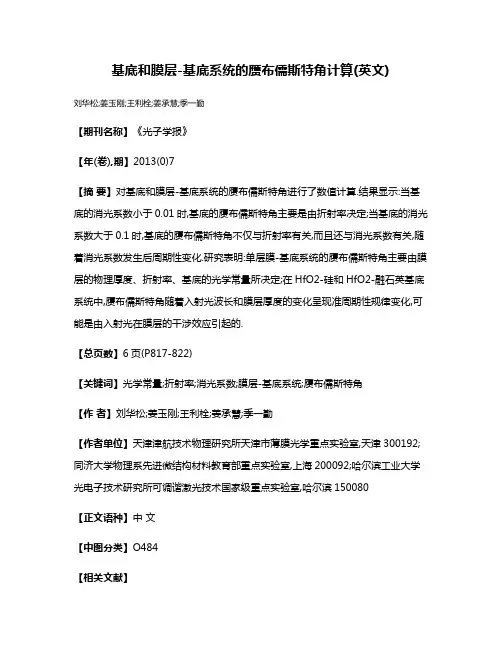
基底和膜层-基底系统的赝布儒斯特角计算(英文)刘华松;姜玉刚;王利栓;姜承慧;季一勤【期刊名称】《光子学报》【年(卷),期】2013(0)7【摘要】对基底和膜层-基底系统的赝布儒斯特角进行了数值计算.结果显示:当基底的消光系数小于0.01时,基底的赝布儒斯特角主要是由折射率决定;当基底的消光系数大于0.1时,基底的赝布儒斯特角不仅与折射率有关,而且还与消光系数有关,随着消光系数发生后周期性变化.研究表明:单层膜-基底系统的赝布儒斯特角主要由膜层的物理厚度、折射率、基底的光学常量所决定;在HfO2-硅和HfO2-融石英基底系统中,赝布儒斯特角随着入射光波长和膜层厚度的变化呈现准周期性规律变化,可能是由入射光在膜层的干涉效应引起的.【总页数】6页(P817-822)【关键词】光学常量;折射率;消光系数;膜层-基底系统;赝布儒斯特角【作者】刘华松;姜玉刚;王利栓;姜承慧;季一勤【作者单位】天津津航技术物理研究所天津市薄膜光学重点实验室,天津300192;同济大学物理系先进微结构材料教育部重点实验室,上海200092;哈尔滨工业大学光电子技术研究所可调谐激光技术国家级重点实验室,哈尔滨150080【正文语种】中文【中图分类】O484【相关文献】1.以介孔TiO2膜为过渡层在玻璃基底上制备Cu3(BTC)2连续膜 [J], 李力成;钱祺;王磊;仇龙云;王昊翊;张所瀛;杨祝红;李小保;赵学娟2.前列腺癌发生发展中基底细胞层和基底膜的改变 [J], 杨敏;刘爱军;韦立新;郭爱桃;宋欣;陈薇3.镍改性层增强铜基底沉积金刚石膜的形核(英文) [J], 刘学璋;魏秋平;翟豪;余志明;4.硅基底上生长金刚石层细晶粒的研究(英文) [J], 何敬晖;玄真武;刘尔凯5.在n型硅基底上二次注入硼离子金刚石膜的p-n结效应(英文) [J], 孙秀平;冯克成;李超;张红霞;费允杰因版权原因,仅展示原文概要,查看原文内容请购买。
在玻色—爱因斯坦凝聚态中类Dicke模型的相变
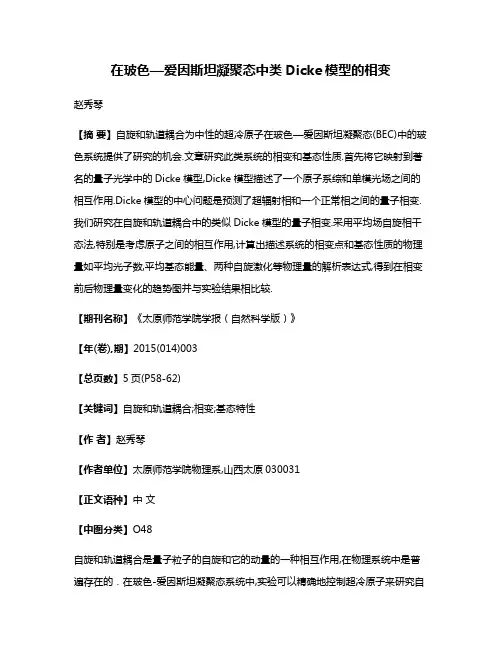
在玻色—爱因斯坦凝聚态中类Dicke模型的相变赵秀琴【摘要】自旋和轨道耦合为中性的超冷原子在玻色—爱因斯坦凝聚态(BEC)中的玻色系统提供了研究的机会.文章研究此类系统的相变和基态性质.首先将它映射到著名的量子光学中的Dicke模型,Dicke模型描述了一个原子系综和单模光场之间的相互作用.Dicke模型的中心问题是预测了超辐射相和一个正常相之间的量子相变.我们研究在自旋和轨道耦合中的类似Dicke模型的量子相变.采用平均场自旋相干态法,特别是考虑原子之间的相互作用,计算出描述系统的相变点和基态性质的物理量如平均光子数,平均基态能量、两种自旋激化等物理量的解析表达式,得到在相变前后物理量变化的趋势图并与实验结果相比较.【期刊名称】《太原师范学院学报(自然科学版)》【年(卷),期】2015(014)003【总页数】5页(P58-62)【关键词】自旋和轨道耦合;相变;基态特性【作者】赵秀琴【作者单位】太原师范学院物理系,山西太原030031【正文语种】中文【中图分类】O48自旋和轨道耦合是量子粒子的自旋和它的动量的一种相互作用,在物理系统中是普遍存在的.在玻色-爱因斯坦凝聚态系统中,实验可以精确地控制超冷原子来研究自旋和轨道耦合相互作用量子多体系统.提出了在玻色-爱因斯坦凝聚态中用中性原子通过控制外场激光场来实现不同类型的自旋轨道耦合[1].NIST的I. B. Spellman 小组通过一对耦合的激光在超冷87Rb原子实现了Rashba 和Dresselhaus自旋轨道耦合[2].在玻色-爱因斯坦凝聚态中,所有的原子都占据同一个量子态,因此基态性质具有特殊性,许多不曾发现过的多体现象有可能发生.例如,在上述自旋和轨道耦合下,玻色-爱因斯坦凝聚态通过调节由两组不同动量的非正交原子缀饰自旋态之间的相互作用,可以实现从自旋相分离态(简写为SP)到单个最小值相(简写为SMP)之间的量子相变[3-5].潘建伟小组在2012年通过测量自旋和动量振荡的振幅比从实验上观察到了理论所预测的量子相变[6].在本文中,首先,根据实验,获得类似于Dicke模型的哈密顿量.通过改变拉曼耦合强度,系统可以从一个自旋极化相,发生了非零准动量SP,与零准动量自旋平衡相SMP 的量子相变,类似于在Dicke模型中从超辐射过渡到正常相的量子相变.利用平均场自旋相干态法,计算相变点,每个物理量在基态时的解析表达式,并研究物理量的变化趋势.图1是超冷87Rb原子被囚禁在xy平面中,ωz是强囚禁势在z方向的频率, 一对Raman入射的激光和x轴成π/4 角, 其拉比(Raman)频率分别是Ω1和Ω2.在拉比激光的作用下,两个超精细基态|F=1,mF=-1〉(|↑〉)和|F=1,mF=0〉(|↓〉)之间就会形成对动量敏感的耦合作用.在缀饰态基矢和下(其中和分别为两束拉比激光的波矢),可以构建相当于凝聚态物理中一维Rashba和Dresselhaus自旋轨道耦合的耦合项,即有效自旋轨道耦合项.相关的非线性Gross-Pitsevskii动力学方程(GP 方程)是[7]在方程(1)中,ψ=(ψ↑,ψ↓)T表示在缀饰态表象中的一对正交波函数.代表谐振子囚禁原子的势能项,m是原子的质量,ωx,ωy 分别是x和y方向的囚禁频率.其自旋轨道耦合项写成:HSOC=2γ0pxσz+ħΩσx其中γ0=ħħ/(mλ)是自旋轨道耦合强度,λ为激光的波长,有效的拉比频率Ω=Ω1Ω2/Δ,σx(z)是泡利矩阵.原子相互碰撞的平均作用为其中相同和不同自旋之间相互作用常数分别为g↑↑=g↑↓=4πħ2N(c0+c2)/(maz)和g↓↓=4πħ2Nc0/(maz),c0和c2为s波散射长度是原子数.所有的超冷原子在强非线性碰撞相互作用下都被限制在相同的基态上,且每个原子具有完全相同的动量.引入玻色算符,不考虑超冷原子与y方向的玻色子模之间的相互作用,通过简单计算,可以获得类似于单模Dicke[8]类型的描述玻色-爱因斯坦凝聚态中自旋和轨道耦合的有效哈密顿量其中a†a是谐振子模†和是集体自旋算符.ψ↑和ψ↓是自旋组分中不同的场算符, q=(g↑↑+g↓↓-2g↑↓)/4ħ是原子间的有效相互作用,很明显,哈密顿量(4)中的〈Jz〉代表自旋不同组分间的原子布局数,在实验中可测得.该系统的性质可以用单模Dicke类型哈密顿量来描述,取自然单位ħ=1,其中ω=Nωx为与原子数相关的囚禁频率是有效的自旋轨道耦合强度.在当前的实验条件下,囚禁频率ωx在NIST实验中可调为10 Hz的数量级,当原子数为N=1.8×105,囚禁频率ω的数量级可调为MHz,拉比激光的波长λ=804.1 nm,所以,参量γ2为kHz的数量级.有效的拉比频率Ω的可调范围可从0到MHz 量级.另外,由于c0=100.86aB,c2=-0.46aB(aB为玻尔半径),所以g↑↑=g↓↓=g↑↓,在这种情况下有效原子相互作用q=0.因此在NIST的实验中原子间有效相互作用q不影响系统的能级结构.但在Feshbach共振时,可通过调节有效原子相互作用的强度在Feshbach共振点附近,其大小甚至可达MHz的量级.本文讨论在Feshbach共振情况下,讨论原子之间的相互作用,对相变和物理量的影响.为方便起见,以作为能量的自然单位,其数量级为kHz.用平均场理论来求相变的关键点,假设基态波函数为[9-11]这里定义相干态a|α〉=α|α〉,自旋相干态定义为对于自旋为1/2的原子j=N/2和θ∈[0,2π]对于原子的平均值方程(5)的哈密顿量的基态能量u和v分别是α的实部和虚部.对应于E(θ,α)的最小值,分别对u和v求偏微分,并令其为零,可得将(10)式和(11)式代入(9)式得,每个原子的平均基态能量变为对于E(θ)最小值有可得cosθ=0,定义Ωc=γ2-q可得两个不同的区域.1)Ω>Ωc,平均场能量只有一个最小值,属于单个最小值相SMP区域.这时,光子数np=v2=0.对(13)式再次求导:并将(16)式代入并且cos2θ=2cos2θ-1=-1,代入得:态是稳定态与Dicke模型中的自旋平衡正常相对应.2)Ω<Ωc,能量最小值对应于(15)式,对应的有两个可能带入取得,对应于自旋相分离态SP范围.对应于凝聚态会有两个最小值的带.对(13)式再次求导,并将(19)式代入得:显然态属于稳定态与Dicke模型中的超辐射相相对应.在图2中当有效的自旋轨道耦合强度(a)γ2=1.8EL(b) γ2=2.6EL是定值时,相变点是一条直线,超辐射相的区域与原子间相互作用力有关,当原子间的相互作用力是排斥力时,即q>0时,区域将减少,当原子间的相互作用力是吸引力即q<0,超辐射的区域增加,并随着有效的自旋轨道耦合强度γ2的增大,如图2(b)相变点向右移.3.1 基态能量的二阶导数和每个原子的平均基态能量每个原子的平均基态能量的二阶导数的分布为:每个原子的平均基态能量分布为:在图3中取γ2=1.8EL(a)可看出基态能量的分布随着有效的Rabi频率Ω的增加而增加.基态能量随着有效的原子之间的相互作用q的增大而增大.当q>0时基态能量较高,当q<0,基态能量较低,在有效的Rabi频率Ω较大时基态能量不受影响.(b)基态能量的泛函的二阶导数在两个区域内都是大于零,说明在这两个区域都是稳定态.3.2 两个方向的自旋极化为在图4中取γ2=2.6EL(a)中〈Jx〉/N随Ω的变化,并且随着γ2的增大,相变点向右移,特别是在(b)中〈Jz〉/N有两个可能值,对应于凝聚态中的两个最小值.总之,我们将凝聚态中的自旋和轨道相互作用中的量子相变和标准的Dicke模型中的量子相变相类比,得出了一维自旋和轨道相互作用,特别是考虑原子之间的相互作用时,用平均场理论可得出类似于标准Dicke模型的量子相变点,光子数分布,基态能量分布和自旋极化的分布情况,并用图表示出来,这种方法非常简洁明了,这与参考文献[10]是一致的.当然我们还有待于考虑失谐的情况,类似于参考文献[12].[1] LIN Y J,GARCIA K J, SPIELMAN I B.Spin-orbit coupled Bose-Einstein condensates[J].Nature,20114,71:83-86[2] KATO Y K,MYERS R C,GOSSARD A C,et al.Observation of the spin Hall effect in semi-conductors[J].Science,2004,306,1910-1913[3] GALITSKI V,SPIELMAN I B.Spin{orbit coupling in quantumgases[J].Nature,2013,494:11841[4] JI S C, ZHANG Jinyi, ZHANG Long,et al.Experimental determination of the finite temperature phase diagram of a spin-orbit coupled Bosegas[J].Nat.Phys,2014(10):314[5] HO T L,ZHANG S Z.Bose-Einstein condensates with spin-orbit interaction[J].Phys. Rev.Lett,2011,107:150403[6] ZHOU X F,LI Y,CAI Z,et al.Unconventional states of bosons with the synthetic spin-orbit coupling[J].J.Phys.B:At.Mol.Opt.Phys,2013,46:134001 [7] LIAN Jinling,ZHANG Yuanwei,LIANG J Q,et al.Thermodynamics of spin-orbit coupled Bose-Einstein condensates[J].Phys.Rev.A,2012,86:063620 [8] DICKE R H.Coherence in Spontaneous RadiationProcesses[J].Phys.Rev,1954,93:99[9] ZHANG J Y,JI S C,CHEN Z,ZHANG L,et al.Collective Dipole Oscillations ofa Spin-Orbit Coupled Bose-EinsteinCondensate[J].Phys.Rev.Lett,2012,109:115301[10] CHRIS Hamner, QU Chunlei, ZHANG Yongping,et al.Dicke-type phase transition in a spin-orbit-coupled Bose-Einsteincondensate[J].Ncomms,2014,5023:1-8[11] ALVERMANN L,ALVERMANN,FEHSKE A,Quantum H.phase transition in the Dicke model with critical and non-criticalentanglement[J].Phys.Rev.A,2012,85:043821[12] ZHAO X Q,LIU N,LIANG J Q.Nonlinear atom-photon-interaction-induced population inversion and inverted quantum phase transition of Bose-Einstein condensate in an optical cavity[J].Phys.Rev.A,2014,90:023622。
螳螂的眼睛
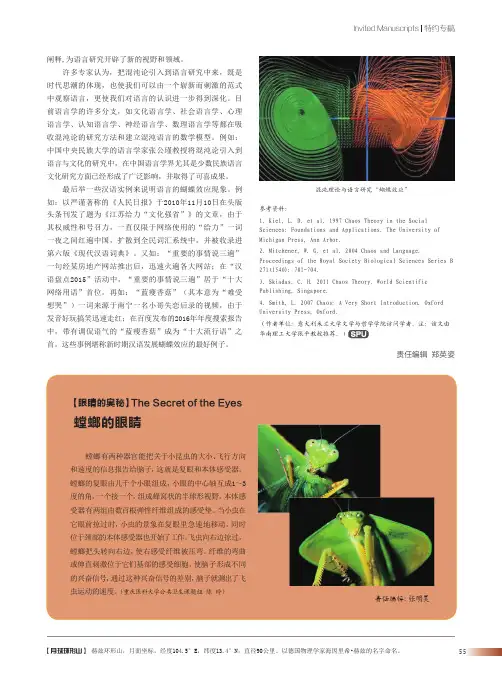
特约专稿Invited Manuscripts 55阐释,为语言研究开辟了新的视野和领域。
许多专家认为,把混沌论引入到语言研究中来,既是时代思潮的体现,也使我们可以由一个崭新而刺激的范式中观察语言,更使我们对语言的认识进一步得到深化。
目前语言学的许多分支,如文化语言学、社会语言学、心理语言学、认知语言学、神经语言学、数理语言学等都在吸收混沌论的研究方法和建立混沌语言的数学模型。
例如:中国中央民族大学的语言学家张公瑾教授将混沌论引入到语言与文化的研究中,在中国语言学界尤其是少数民族语言文化研究方面已经形成了广泛影响,并取得了可喜成果。
最后举一些汉语实例来说明语言的蝴蝶效应现象。
例如:以严谨著称的《人民日报》于2010年11月10日在头版头条刊发了题为《江苏给力“文化强省”》的文章,由于其权威性和号召力,一直仅限于网络使用的“给力”一词一夜之间红遍中国,扩散到全民词汇系统中,并被收录进第六版《现代汉语词典》。
又如:“重要的事情说三遍”一句经某房地产网站推出后,迅速火遍各大网站;在“汉语盘点2015”活动中,“重要的事情说三遍”居于“十大网络用语”首位。
再如:“蓝瘦香菇”(其本意为“难受想哭”)一词来源于南宁一名小哥失恋后录的视频,由于发音好玩搞笑迅速走红;在百度发布的2016年年度搜索报告中,带有调侃语气的“蓝瘦香菇”成为“十大流行语”之首。
这些事例堪称新时期汉语发展蝴蝶效应的最好例子。
参考资料:1. Kiel, L. D. et al. 1997 Chaos Theory in the Social Sciences: Foundations and Applications. The University of Michigan Press, Ann Arbor.2. Mitchener, W. G. et al. 2004 Chaos and Language.Proceedings of the Royal Society Biological Sciences Series B 271(1540): 701-704.3. Skiadas, C. H. 2011 Chaos Theory. World Scientific Publishing, Singapore.4. Smith, L. 2007 Chaos: A Very Short Introduction. Oxford University Press, Oxford.(作者单位:意大利米兰大学文学与哲学学院访问学者。
caley hamilton定理
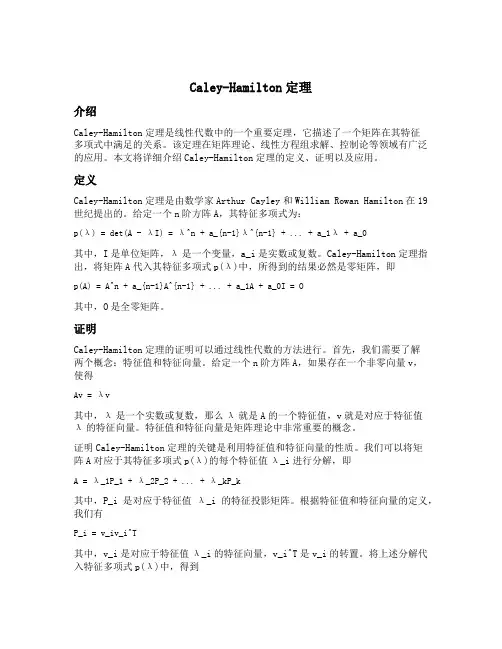
Caley-Hamilton定理介绍Caley-Hamilton定理是线性代数中的一个重要定理,它描述了一个矩阵在其特征多项式中满足的关系。
该定理在矩阵理论、线性方程组求解、控制论等领域有广泛的应用。
本文将详细介绍Caley-Hamilton定理的定义、证明以及应用。
定义Caley-Hamilton定理是由数学家Arthur Cayley和William Rowan Hamilton在19世纪提出的。
给定一个n阶方阵A,其特征多项式为:p(λ) = det(A - λI) = λ^n + a_{n-1}λ^{n-1} + ... + a_1λ + a_0其中,I是单位矩阵,λ是一个变量,a_i是实数或复数。
Caley-Hamilton定理指出,将矩阵A代入其特征多项式p(λ)中,所得到的结果必然是零矩阵,即p(A) = A^n + a_{n-1}A^{n-1} + ... + a_1A + a_0I = O其中,O是全零矩阵。
证明Caley-Hamilton定理的证明可以通过线性代数的方法进行。
首先,我们需要了解两个概念:特征值和特征向量。
给定一个n阶方阵A,如果存在一个非零向量v,使得Av = λv其中,λ是一个实数或复数,那么λ就是A的一个特征值,v就是对应于特征值λ的特征向量。
特征值和特征向量是矩阵理论中非常重要的概念。
证明Caley-Hamilton定理的关键是利用特征值和特征向量的性质。
我们可以将矩阵A对应于其特征多项式p(λ)的每个特征值λ_i进行分解,即A = λ_1P_1 + λ_2P_2 + ... + λ_kP_k其中,P_i是对应于特征值λ_i的特征投影矩阵。
根据特征值和特征向量的定义,我们有P_i = v_iv_i^T其中,v_i是对应于特征值λ_i的特征向量,v_i^T是v_i的转置。
将上述分解代入特征多项式p(λ)中,得到p(A) = p(λ_1P_1 + λ_2P_2 + ... + λ_kP_k)= p(λ_1)v_1v_1^T + p(λ_2)v_2v_2^T + ... + p(λ_k)v_kv_k^T由于特征值λ_i是特征多项式p(λ)的根,所以我们有p(λ_i) = 0将上述等式代入p(A)中,得到p(A) = 0 + 0 + ... + 0 = O因此,Caley-Hamilton定理得证。
数学家--中英文对照
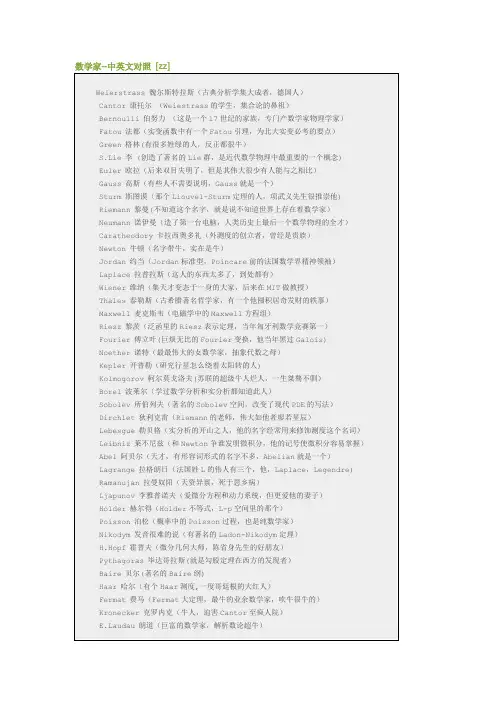
数学家--中英文对照[zz]Weierstrass 魏尔斯特拉斯(古典分析学集大成者,德国人)Cantor 康托尔(Weiestrass的学生,集合论的鼻祖)Bernoulli 伯努力(这是一个17世纪的家族,专门产数学家物理学家)Fatou 法都(实变函数中有一个Fatou引理,为北大实变必考的要点)Green 格林(有很多姓绿的人,反正都很牛)S.Lie 李 (创造了著名的Lie群,是近代数学物理中最重要的一个概念)Euler 欧拉(后来双目失明了,但是其伟大很少有人能与之相比)Gauss 高斯(有些人不需要说明,Gauss就是一个)Sturm 斯图谟(那个Liouvel-Sturm定理的人,项武义先生很推崇他)Riemann 黎曼(不知道这个名字,就是说不知道世界上存在着数学家)Neumann 诺伊曼(造了第一台电脑,人类历史上最后一个数学物理的全才)Caratheodory 卡拉西奥多礼(外测度的创立者,曾经是贵族)Newton 牛顿(名字带牛,实在是牛)Jordan 约当(Jordan标准型,Poincare前的法国数学界精神领袖)Laplace 拉普拉斯(这人的东西太多了,到处都有)Wiener 维纳(集天才变态于一身的大家,后来在MIT做教授)Thales 泰勒斯(古希腊著名哲学家,有一个他囤积居奇发财的轶事)Maxwell 麦克斯韦(电磁学中的Maxwell方程组)Riesz 黎茨(泛函里的Riesz表示定理,当年匈牙利数学竞赛第一)Fourier 傅立叶(巨烦无比的Fourier变换,他当年黑过Galois)Noether 诺特(最最伟大的女数学家,抽象代数之母)Kepler 开普勒(研究行星怎么绕着太阳转的人)Kolmogorov 柯尔莫戈洛夫(苏联的超级牛人烂人,一生桀骜不驯)Borel 波莱尔(学过数学分析和实分析都知道此人)Sobolev 所伯列夫(著名的Sobolev空间,改变了现代PDE的写法)Dirchlet 狄利克雷(Riemann的老师,伟大如他者廖若星辰)Lebesgue 勒贝格(实分析的开山之人,他的名字经常用来修饰测度这个名词) Leibniz 莱不尼兹(和Newton争谁发明微积分,他的记号使微积分容易掌握) Abel 阿贝尔(天才,有形容词形式的名字不多,Abelian就是一个)Lagrange 拉格朗日(法国姓L的伟人有三个,他,Laplace,Legendre) Ramanujan 拉曼奴阳(天资异禀,死于思乡病)Ljapunov 李雅普诺夫(爱微分方程和动力系统,但更爱他的妻子)Hold er 赫尔得(Holder不等式,L-p空间里的那个)Poisson 泊松(概率中的Poisson过程,也是纯数学家)Nikodym 发音很难的说(有著名的Ladon-Nikodym定理)H.Hopf 霍普夫(微分几何大师,陈省身先生的好朋友)Pythagoras 毕达哥拉斯(就是勾股定理在西方的发现者)Baire 贝尔(著名的Baire纲)Haar 哈尔(有个Haar测度,一度哥廷根的大红人)Fermat 费马(Fermat大定理,最牛的业余数学家,吹牛很牛的)Kronecker 克罗内克(牛人,迫害Cantor至疯人院)udau 朗道(巨富的数学家,解析数论超牛)Markov 马尔可夫(Markov过程)Wronski 朗斯基(微分方程中有个Wronski行列式,用来解线性方程组的)Zermelo 策梅罗(集合论的专家,有以他的名字命名的公理体系)Rouche 儒契(在复变中有Rouche定理Rouche函数)Taylor 泰勒(Taylor有很多,最熟的一个恐怕是Taylor展开的那个)Urysohn 乌里松(在拓扑中有著名的Urysohn定理)Frechet 发音巨难的说,泛函中的Frechet空间Picard 皮卡(大小Picard定理,心高气敖,很没有人缘)Schauder 肖德尔(泛函中有Schauder基Schauder不动点定理)Lipschiz 李普西茨(Lipshciz条件,研究函数光滑性的)Liouville 刘维尔(用Liouville定理证明代数基本定理应该是最快的方法)Lindelof 林德洛夫(证明了圆周率是超越数,讲课奇差)de Moivre 棣莫佛(复数的乘法又一个他的定理,很简单的那个)Klein 克莱因(著名的爱尔兰根纲领,哥廷根的精神领袖)Bessel 贝塞尔(Hilbert空间一个东西的范数用基表示有一个Bessel定理)Euclid 欧几里德(我们的平面几何学的都是2000前他的书)Kummer 库默尔(数论中最有影响的几个人之一)Ascoli 阿斯克里(有Ascoli-Arzela定理,要一致有界等度连续的那个)Chebyschev 切比雪夫(他证明了n和2n之间有一个素数)Banach 巴拿赫(波兰的牛人,泛函分析之父)Hilbert 希尔伯特(这个也没有介绍的必要)Minkowski 闵可夫斯基(Hilbert的挚友,Einstein的“恩师”)Hamilton 哈密尔顿(第一个发现了4元数,在一座桥上)Poincare 彭加莱(数学界的莎士比亚)Peano 皮亚诺(有Peano公理,和数学归纳法有关系)Zorn 佐恩(Zorn引理,看起来显然的东西都用这个证明)一、伯努利家族Bernoulli(伯努利)家族(1)Euler(欧拉)停止了生命,也就停止了计算。
变分方法与无穷维Hamilton系统

第二章至第四章的内容是关于变分方法的基础知识。第二章介绍了变分法的历 史发展和基本概念,如泛函、临界点等。第三章详细阐述了Euler-Lagrange 方程及其在最小作用原理中的应用。第四章则进一步讨论了变分法在约束力学 系统中的应用和Legendre变换。
第五章至第七章聚焦于无穷维Hamilton系统的相关理论。第五章概述了 Hamilton系统的基本概念和性质,第六章详细介绍了无穷维Hamilton系统的 形成和基本性质,第七章则讨论了无穷维Hamilton系统的应用领域和实例。
在这本书中,作者详细介绍了无穷维Hamilton系统的基本原理和性质,以及 如何使用这个系统来描述各种自然现象和社会现象。通过阅读这本书,我不仅 学到了很多关于数学和物理的知识,也更加明白了这个世界是如何运作的。
《变分方法与无穷维Hamilton系统》是一本非常值得一读的书。通过阅读这 本书,我不仅学到了很多关于数学和物理的知识,也更加明白了数学在描述世 界中的重要性。这本书的写作风格清晰易懂,使得即使是没有深入了解过这两 个领域的读者也能感兴趣的普通人来说,这本书都会是一本非常有价值的读物。
“在处理无穷维Hamilton系统时,变分方法的应用不仅能够帮助我们找到系 统的稳定状态,还能揭示出系统在演化过程中的重要特征。这为解决实际问题 提供了有效的理论支持。”
“无穷维Hamilton系统的变分方法涉及许多高阶微分方程和积分方程的求解。 这些方程的解不仅有助于我们理解系统的基本性质,还能为设计高效的数值算 法提供指导。”
变分方法与无穷维Hamilton系统
读书笔记
01 思维导图
03 精彩摘录 05 目录分析
目录
02 内容摘要 04 阅读感受 06 作者简介
思维导图
吉布斯---亥姆霍兹方程精品课件
该式是由吉布斯(Gibbs)和亥姆霍兹(Helmholtz) 各自独立证明的,故此式叫吉布斯—亥姆霍兹 (Gibbs--- Helmholtz)公式。
精品 PPT 欢迎下载 可修改
5
吉布斯—亥姆霍兹方程
吉布斯—亥姆霍兹方程运用
自由能判据:吉布斯—亥姆霍兹公式表明,恒 温恒压下进行的化学反应的方向和限度的判据—— 自由能地变化是由两项决定:一项是焓变△H,另 一项是与熵变有关的T△S。如这两个量使△G成为 负值,则正反应是一个自发反应。因此,焓和熵对 化学反应进行的方向都产生影响,只是在不同条件 下产生的影响的大小不同而已。
•
14、抱最大的希望,作最大的努力。2020年10月3日 星期六 下午3时54分10秒15:54:1020.10.3
•
15、一个人炫耀什么,说明他内心缺 少什么 。。2020年10月下午3时54分 20.10.315:54October 3, 2020
•
16、业余生活要有意义,不要越轨。2020年10月3日 星期六 3时54分10秒15:54:103 October 2020
•
17、一个人即使已登上顶峰,也仍要 自强不 息。下 午3时54分10秒 下午3时54分15:54:1020.10.3
谢谢大家
精品 PPT 欢迎下载 可修改
10
精品 PPT 欢迎下载 可修改
3
精品 PPT 欢迎下载 可修改
4
吉布斯—亥姆霍兹方程
吉布斯—亥姆霍兹方程来由
1876年,Gibbs提出一个把焓和熵归并在一起的状 态函数被称为吉布斯(Gibbs)自由能,用符号G表示, 其定义式为:G=H-TS。据此定义,等温过程的吉布 斯自由能变化△G :
1992年诺贝尔物理学奖----多斯正比室的发明夏...-物理实验教学中心
1991年诺贝尔物理学奖----液晶和聚合物德然纳(Pierre Gilles de Gennes,1932-- )1991年诺贝尔物理学奖授予法国的德纳然,以表彰他把研究简单系统中有序现象的方法推广到更复杂的物理态,特别是液晶和聚合物所做的贡献。
德然纳用数学方法描述磁欧极子、长分子或分子链是怎样在特定条件下形成有序态的,并阐明了当这些物质从有序态过渡到无序态发生了些甚麽事情。
例如,在加热磁体时,就会发生这类有序-无序的变化。
而由无序到有序的转变往往发生在确定的温度下,有时也出现跳跃式的变化,这就是在临界态下的相变,对于铁磁体来说,这个温度就是所谓的距离点。
1992年诺贝尔物理学奖----多斯正比室的发明夏帕克(Georges Charpak,1924-- )1992年诺贝尔物理学奖授予瑞士日内瓦欧洲核子研究中心的夏帕克,以表彰他对高能物理探测器,特别是多斯正比室的发明和发展。
从1959年起,夏帕克在欧洲核子研究中心工作,这是欧洲建立在瑞士日内瓦州的粒子物理实验室。
在那里,夏帕克发明了多斯正比室。
这一开创性成果发表于1968年。
由于他在这方面的工作,粒子物理学家才能够把他们的兴趣集中在非常罕见的例子之间的相互作用,这类相互作用往往可以揭示物质内部深层次的奥秘。
1993年诺贝尔物理学奖----新型脉冲星小约瑟夫.泰勒 (Joseph H。
Haylor,Jr,1941-- ) 拉塞尔.赫尔斯(Russell A.Hulse,1915-- )1993年诺贝尔物理学奖授予美国新泽西州普林斯顿大学的赫尔斯和小约瑟夫,泰勒,以表彰他们发现了一种新型的脉冲星,这一发现为研究引力开辟了新的可能性。
赫尔斯和泰勒是在1974年用西印度群岛波多黎各的300m 射电望远镜发现这种新型脉冲星的。
当时泰勒在阿墨斯特(Amherst)麻萨诸塞大学任教授,赫尔斯是他的研究生。
脉冲星是一种质量比太阳大而半径大约只有十几公里的快速旋转的"宇宙信号"(假如有一个人站在脉冲星上,其重量会比在地面上大千亿倍)。
量子力学索引英汉对照
21-centimeter line, 21厘米线AAbsorption, 吸收Addition of angular momenta, 角动量叠加Adiabatic approximation, 绝热近似Adiabatic process, 绝热过程Adjoint, 自伴的Agnostic position, 不可知论立场Aharonov-Bohm effect, 阿哈罗诺夫—玻姆效应Airy equation, 艾里方程;Airy function, 艾里函数Allowed energy, 允许能量Allowed transition, 允许跃迁Alpha decay, α衰变;Alpha particle, α粒子Angular equation, 角向方程Angular momentum, 角动量Anomalous magnetic moment, 反常磁矩Antibonding, 反键Anti-hermitian operator, 反厄米算符Associated Laguerre polynomial, 连带拉盖尔多项式Associated Legendre function, 连带勒让德多项式Atoms, 原子Average value, 平均值Azimuthal angle, 方位角Azimuthal quantum number, 角量子数BBalmer series, 巴尔末线系Band structure, 能带结构Baryon, 重子Berry's phase, 贝利相位Bessel functions, 贝塞尔函数Binding energy, 束缚能Binomial coefficient, 二项式系数Biot-Savart law, 毕奥—沙法尔定律Blackbody spectrum, 黑体谱Bloch's theorem, 布洛赫定理Bohr energies, 玻尔能量;Bohr magneton, 玻尔磁子;Bohr radius, 玻尔半径Boltzmann constant, 玻尔兹曼常数Bond, 化学键Born approximation, 玻恩近似Born's statistical interpretation, 玻恩统计诠释Bose condensation, 玻色凝聚Bose-Einstein distribution, 玻色—爱因斯坦分布Boson, 玻色子Bound state, 束缚态Boundary conditions, 边界条件Bra, 左矢Bulk modulus, 体积模量CCanonical commutation relations, 正则对易关系Canonical momentum, 正则动量Cauchy's integral formula, 柯西积分公式Centrifugal term, 离心项Chandrasekhar limit, 钱德拉赛卡极限Chemical potential, 化学势Classical electron radius, 经典电子半径Clebsch-Gordan coefficients, 克—高系数Coherent States, 相干态Collapse of wave function, 波函数塌缩Commutator, 对易子Compatible observables, 对易的可观测量Complete inner product space, 完备内积空间Completeness, 完备性Conductor, 导体Configuration, 位形Connection formulas, 连接公式Conservation, 守恒Conservative systems, 保守系Continuity equation, 连续性方程Continuous spectrum, 连续谱Continuous variables, 连续变量Contour integral, 围道积分Copenhagen interpretation, 哥本哈根诠释Coulomb barrier, 库仑势垒Coulomb potential, 库仑势Covalent bond, 共价键Critical temperature, 临界温度Cross-section, 截面Crystal, 晶体Cubic symmetry, 立方对称性Cyclotron motion, 螺旋运动DDarwin term, 达尔文项de Broglie formula, 德布罗意公式de Broglie wavelength, 德布罗意波长Decay mode, 衰变模式Degeneracy, 简并度Degeneracy pressure, 简并压Degenerate perturbation theory, 简并微扰论Degenerate states, 简并态Degrees of freedom, 自由度Delta-function barrier, δ势垒Delta-function well, δ势阱Derivative operator, 求导算符Determinant, 行列式Determinate state, 确定的态Deuterium, 氘Deuteron, 氘核Diagonal matrix, 对角矩阵Diagonalizable matrix, 对角化Differential cross-section, 微分截面Dipole moment, 偶极矩Dirac delta function, 狄拉克δ函数Dirac equation, 狄拉克方程Dirac notation, 狄拉克记号Dirac orthonormality, 狄拉克正交归一性Direct integral, 直接积分Discrete spectrum, 分立谱Discrete variable, 离散变量Dispersion relation, 色散关系Displacement operator, 位移算符Distinguishable particles, 可分辨粒子Distribution, 分布Doping, 掺杂Double well, 双势阱Dual space, 对偶空间Dynamic phase, 动力学相位EEffective nuclear charge, 有效核电荷Effective potential, 有效势Ehrenfest's theorem, 厄伦费斯特定理Eigenfunction, 本征函数Eigenvalue, 本征值Eigenvector, 本征矢Einstein's A and B coefficients, 爱因斯坦A,B系数;Einstein's mass-energy formula, 爱因斯坦质能公式Electric dipole, 电偶极Electric dipole moment, 电偶极矩Electric dipole radiation, 电偶极辐射Electric dipole transition, 电偶极跃迁Electric quadrupole transition, 电四极跃迁Electric field, 电场Electromagnetic wave, 电磁波Electron, 电子Emission, 发射Energy, 能量Energy-time uncertainty principle, 能量—时间不确定性关系Ensemble, 系综Equilibrium, 平衡Equipartition theorem, 配分函数Euler's formula, 欧拉公式Even function, 偶函数Exchange force, 交换力Exchange integral, 交换积分Exchange operator, 交换算符Excited state, 激发态Exclusion principle, 不相容原理Expectation value, 期待值FFermi-Dirac distribution, 费米—狄拉克分布Fermi energy, 费米能Fermi surface, 费米面Fermi temperature, 费米温度Fermi's golden rule, 费米黄金规则Fermion, 费米子Feynman diagram, 费曼图Feynman-Hellman theorem, 费曼—海尔曼定理Fine structure, 精细结构Fine structure constant, 精细结构常数Finite square well, 有限深方势阱First-order correction, 一级修正Flux quantization, 磁通量子化Forbidden transition, 禁戒跃迁Foucault pendulum, 傅科摆Fourier series, 傅里叶级数Fourier transform, 傅里叶变换Free electron, 自由电子Free electron density, 自由电子密度Free electron gas, 自由电子气Free particle, 自由粒子Function space, 函数空间Fusion, 聚变Gg-factor, g—因子Gamma function, Γ函数Gap, 能隙Gauge invariance, 规范不变性Gauge transformation, 规范变换Gaussian wave packet, 高斯波包Generalized function, 广义函数Generating function, 生成函数Generator, 生成元Geometric phase, 几何相位Geometric series, 几何级数Golden rule, 黄金规则"Good" quantum number, “好”量子数"Good" states, “好”的态Gradient, 梯度Gram-Schmidt orthogonalization, 格莱姆—施密特正交化法Graphical solution, 图解法Green's function, 格林函数Ground state, 基态Group theory, 群论Group velocity, 群速Gyromagnetic railo, 回转磁比值HHalf-integer angular momentum, 半整数角动量Half-life, 半衰期Hamiltonian, 哈密顿量Hankel functions, 汉克尔函数Hannay's angle, 哈内角Hard-sphere scattering, 硬球散射Harmonic oscillator, 谐振子Heisenberg picture, 海森堡绘景Heisenberg uncertainty principle, 海森堡不确定性关系Helium, 氦Helmholtz equation, 亥姆霍兹方程Hermite polynomials, 厄米多项式Hermitian conjugate, 厄米共轭Hermitian matrix, 厄米矩阵Hidden variables, 隐变量Hilbert space, 希尔伯特空间Hole, 空穴Hooke's law, 胡克定律Hund's rules, 洪特规则Hydrogen atom, 氢原子Hydrogen ion, 氢离子Hydrogen molecule, 氢分子Hydrogen molecule ion, 氢分子离子Hydrogenic atom, 类氢原子Hyperfine splitting, 超精细分裂IIdea gas, 理想气体Idempotent operaror, 幂等算符Identical particles, 全同粒子Identity operator, 恒等算符Impact parameter, 碰撞参数Impulse approximation, 脉冲近似Incident wave, 入射波Incoherent perturbation, 非相干微扰Incompatible observables, 不对易的可观测量Incompleteness, 不完备性Indeterminacy, 非确定性Indistinguishable particles, 不可分辨粒子Infinite spherical well, 无限深球势阱Infinite square well, 无限深方势阱Inner product, 内积Insulator, 绝缘体Integration by parts, 分部积分Intrinsic angular momentum, 内禀角动量Inverse beta decay, 逆β衰变Inverse Fourier transform, 傅里叶逆变换KKet, 右矢Kinetic energy, 动能Kramers' relation, 克莱默斯关系Kronecker delta, 克劳尼克δLLCAO technique, 原子轨道线性组合法Ladder operators, 阶梯算符Lagrange multiplier, 拉格朗日乘子Laguerre polynomial, 拉盖尔多项式Lamb shift, 兰姆移动Lande g-factor, 朗德g—因子Laplacian, 拉普拉斯的Larmor formula, 拉摩公式Larmor frequency, 拉摩频率Larmor precession, 拉摩进动Laser, 激光Legendre polynomial, 勒让德多项式Levi-Civita symbol, 列维—西维塔符号Lifetime, 寿命Linear algebra, 线性代数Linear combination, 线性组合Linear combination of atomic orbitals, 原子轨道的线性组合Linear operator, 线性算符Linear transformation, 线性变换Lorentz force law, 洛伦兹力定律Lowering operator, 下降算符Luminoscity, 照度Lyman series, 赖曼线系MMagnetic dipole, 磁偶极Magnetic dipole moment, 磁偶极矩Magnetic dipole transition, 磁偶极跃迁Magnetic field, 磁场Magnetic flux, 磁通量Magnetic quantum number, 磁量子数Magnetic resonance, 磁共振Many worlds interpretation, 多世界诠释Matrix, 矩阵;Matrix element, 矩阵元Maxwell-Boltzmann distribution, 麦克斯韦—玻尔兹曼分布Maxwell’s equations, 麦克斯韦方程Mean value, 平均值Measurement, 测量Median value, 中位值Meson, 介子Metastable state, 亚稳态Minimum-uncertainty wave packet, 最小不确定度波包Molecule, 分子Momentum, 动量Momentum operator, 动量算符Momentum space wave function, 动量空间波函数Momentum transfer, 动量转移Most probable value, 最可几值Muon, μ子Muon-catalysed fusion, μ子催化的聚变Muonic hydrogen, μ原子Muonium, μ子素NNeumann function, 纽曼函数Neutrino oscillations, 中微子振荡Neutron star, 中子星Node, 节点Nomenclature, 术语Nondegenerate perturbationtheory, 非简并微扰论Non-normalizable function, 不可归一化的函数Normalization, 归一化Nuclear lifetime, 核寿命Nuclear magnetic resonance, 核磁共振Null vector, 零矢量OObservable, 可观测量Observer, 观测者Occupation number, 占有数Odd function, 奇函数Operator, 算符Optical theorem, 光学定理Orbital, 轨道的Orbital angular momentum, 轨道角动量Orthodox position, 正统立场Orthogonality, 正交性Orthogonalization, 正交化Orthohelium, 正氦Orthonormality, 正交归一性Orthorhombic symmetry, 斜方对称Overlap integral, 交叠积分PParahelium, 仲氦Partial wave amplitude, 分波幅Partial wave analysis, 分波法Paschen series, 帕邢线系Pauli exclusion principle, 泡利不相容原理Pauli spin matrices, 泡利自旋矩阵Periodic table, 周期表Perturbation theory, 微扰论Phase, 相位Phase shift, 相移Phase velocity, 相速Photon, 光子Planck's blackbody formula, 普朗克黑体辐射公式Planck's constant, 普朗克常数Polar angle, 极角Polarization, 极化Population inversion, 粒子数反转Position, 位置;Position operator, 位置算符Position-momentum uncertainty principles, 位置—动量不确定性关系Position space wave function, 坐标空间波函数Positronium, 电子偶素Potential energy, 势能Potential well, 势阱Power law potential, 幂律势Power series expansion, 幂级数展开Principal quantum number, 主量子数Probability, 几率Probability current, 几率流Probability density, 几率密度Projection operator, 投影算符Propagator, 传播子Proton, 质子QQuantum dynamics, 量子动力学Quantum electrodynamics, 量子电动力学Quantum number, 量子数Quantum statics, 量子统计Quantum statistical mechanics, 量子统计力学Quark, 夸克RRabi flopping frequency, 拉比翻转频率Radial equation, 径向方程Radial wave function, 径向波函数Radiation, 辐射Radius, 半径Raising operator, 上升算符Rayleigh's formula, 瑞利公式Realist position, 实在论立场Recursion formula, 递推公式Reduced mass, 约化质量Reflected wave, 反射波Reflection coefficient, 反射系数Relativistic correction, 相对论修正Rigid rotor, 刚性转子Rodrigues formula, 罗德里格斯公式Rotating wave approximation, 旋转波近似Rutherford scattering, 卢瑟福散射Rydberg constant, 里德堡常数Rydberg formula, 里德堡公式SScalar potential, 标势Scattering, 散射Scattering amplitude, 散射幅Scattering angle, 散射角Scattering matrix, 散射矩阵Scattering state, 散射态Schrodinger equation, 薛定谔方程Schrodinger picture, 薛定谔绘景Schwarz inequality, 施瓦兹不等式Screening, 屏蔽Second-order correction, 二级修正Selection rules, 选择定则Semiconductor, 半导体Separable solutions, 分离变量解Separation of variables, 变量分离Shell, 壳Simple harmonic oscillator, 简谐振子Simultaneous diagonalization, 同时对角化Singlet state, 单态Slater determinant, 斯拉特行列式Soft-sphere scattering, 软球散射Solenoid, 螺线管Solids, 固体Spectral decomposition, 谱分解Spectrum, 谱Spherical Bessel functions, 球贝塞尔函数Spherical coordinates, 球坐标Spherical Hankel functions, 球汉克尔函数Spherical harmonics, 球谐函数Spherical Neumann functions, 球纽曼函数Spin, 自旋Spin matrices, 自旋矩阵Spin-orbit coupling, 自旋—轨道耦合Spin-orbit interaction, 自旋—轨道相互作用Spinor, 旋量Spin-spin coupling, 自旋—自旋耦合Spontaneous emission, 自发辐射Square-integrable function, 平方可积函数Square well, 方势阱Standard deviation, 标准偏差Stark effect, 斯塔克效应Stationary state, 定态Statistical interpretation, 统计诠释Statistical mechanics, 统计力学Stefan-Boltzmann law, 斯特番—玻尔兹曼定律Step function, 阶跃函数Stem-Gerlach experiment, 斯特恩—盖拉赫实验Stimulated emission, 受激辐射Stirling's approximation, 斯特林近似Superconductor, 超导体Symmetrization, 对称化Symmetry, 对称TTaylor series, 泰勒级数Temperature, 温度Tetragonal symmetry, 正方对称Thermal equilibrium, 热平衡Thomas precession, 托马斯进动Time-dependent perturbation theory, 含时微扰论Time-dependent Schrodinger equation, 含时薛定谔方程Time-independent perturbation theory, 定态微扰论Time-independent Schrodinger equation, 定态薛定谔方程Total cross-section, 总截面Transfer matrix, 转移矩阵Transformation, 变换Transition, 跃迁;Transition probability, 跃迁几率Transition rate, 跃迁速率Translation,平移Transmission coefficient, 透射系数Transmitted wave, 透射波Trial wave function, 试探波函数Triplet state, 三重态Tunneling, 隧穿Turning points, 回转点Two-fold degeneracy , 二重简并Two-level systems, 二能级体系UUncertainty principle, 不确定性关系Unstable particles, 不稳定粒子VValence electron, 价电子Van der Waals interaction, 范德瓦尔斯相互作用Variables, 变量Variance, 方差Variational principle, 变分原理Vector, 矢量Vector potential, 矢势Velocity, 速度Vertex factor, 顶角因子Virial theorem, 维里定理WWave function, 波函数Wavelength, 波长Wave number, 波数Wave packet, 波包Wave vector, 波矢White dwarf, 白矮星Wien's displacement law, 维恩位移定律YYukawa potential, 汤川势ZZeeman effect, 塞曼效应。
《2024年无穷维Hamilton算子的拟谱》范文
《无穷维Hamilton算子的拟谱》篇一摘要:本文旨在探讨无穷维Hamilton算子的拟谱问题。
首先,我们将介绍Hamilton算子的基本概念及其在物理和数学领域的重要性。
随后,我们将阐述拟谱方法的基本原理和在处理无穷维系统中的优势。
最后,我们将详细描述我们的研究方法和结果,以及这些结果对无穷维系统理论和相关领域研究的潜在贡献。
一、引言Hamilton算子是一种广泛应用于量子力学、光学、电磁学等领域的数学工具。
在处理具有无穷维度的系统时,Hamilton算子的谱问题变得尤为重要。
然而,由于无穷维系统的复杂性,直接求解其谱往往面临巨大挑战。
因此,寻求有效的拟谱方法成为研究的关键。
二、Hamilton算子的基本概念Hamilton算子是一种描述系统动力学的算子,具有特定的形式和性质。
在量子力学中,它描述了粒子的能量和动量关系。
在光学和电磁学中,它用于描述光场或电磁场的演化。
由于系统的复杂性,Hamilton算子往往具有无穷维度,使得其谱的求解变得困难。
三、拟谱方法的基本原理及优势拟谱方法是一种用于处理无穷维系统的数学方法。
它通过将系统在一定的近似空间中进行展开,将原本复杂的无穷维问题转化为有限维问题进行处理。
这种方法在处理具有复杂相互作用的系统时具有显著优势,能够有效地降低问题的复杂度。
四、无穷维Hamilton算子的拟谱研究针对无穷维Hamilton算子的拟谱问题,我们采用了一种基于拟谱方法的解决方案。
首先,我们选择了一个合适的近似空间,将Hamilton算子在这个空间中进行展开。
然后,我们利用数值方法求解展开后的有限维问题,得到Hamilton算子的近似谱。
最后,我们通过分析近似谱的性质,了解原系统的动力学特性。
五、研究方法与结果我们采用了一种基于多项式展开的拟谱方法。
首先,我们选择了一组合适的多项式基函数作为近似空间的基底。
然后,我们将Hamilton算子在这组基底上进行展开,得到一个有限维的矩阵表示。
- 1、下载文档前请自行甄别文档内容的完整性,平台不提供额外的编辑、内容补充、找答案等附加服务。
- 2、"仅部分预览"的文档,不可在线预览部分如存在完整性等问题,可反馈申请退款(可完整预览的文档不适用该条件!)。
- 3、如文档侵犯您的权益,请联系客服反馈,我们会尽快为您处理(人工客服工作时间:9:00-18:30)。
a r X i v :c o n d -m a t /0306374v 4 [c o n d -m a t .s t a t -m e c h ] 8 O c t 2003Glassy Phase in the Hamiltonian Mean Field modelAlessandro Pluchino,Vito Latora and Andrea RapisardaDipartimento di Fisica e Astronomia,Universit`a di Catania,and INFN sezione di Catania,Via S.Sofia 64,95123Catania,Italy(Dated:February 6,2008)We study the relaxation dynamics of a Hamiltonian system of N fully-coupled XY spins.The thermodynamics of the system predicts a ferromagnetic and a paramagnetic phase.Starting from out-of-equilibrium initial conditions,the dynamics at constant energy drives the system into quasi-stationary states (QSS)characterized by dynamical frustration.We introduce the spin polarization as a new order parameter which allows to interpret the dynamically generated QSS regime as a glassy phase of the model.PACS numbers:75.10.Nr,89.75.Fb,64.60.FrThe Hamiltonian Mean Field (HMF)model,originally introduced in Ref.[1],has been intensively studied in the last years for its extreme richness and flexibility in explor-ing the connections between dynamics and thermody-namics in long-range many-body systems.In fact,on one hand the model has an exact equilibrium solution,on the other hand,because of the presence of a kinetic energy term in the Hamiltonian,the dynamics can be studied by means of molecular dynamics simulations [1,2,3,4].From these investigations,many new interesting features have emerged which are common to other systems with long-range interactions [5,6,7].One of the most intrigu-ing characteristics of the dynamics is the existence of quasi-stationary states (QSS),i.e.dynamically-created states,whose lifetime diverges with the system size N [8].In such states anomalous diffusion [3],non-Gaussian velocity distributions [8],vanishing Lyapunov exponents [8],ergodicity breaking and slow-decaying correlations [9,10]have been observed.These features have sug-gested a possible application of Tsallis generalized ther-modynamics [8,11,12,13,14].In this paper we show that the HMF model in the QSS regime behaves similary to a glassy system.In fact,by means of a new order parameter,it is possible to char-acterize the dynamically generated QSS as a thermody-namics glassy phase of the model,despite the fact that neither disorder nor frustration are a-priori present in the interaction.The main idea of the paper originated from the observation of slow relaxation and aging [9,10]in the QSS regime.Such a behavior is typical of frus-trated systems,whose prototype are spin-glasses [15]:in these systems,the impossibility to minimize simultane-ously the interaction energies of all the couples of spins leads the system to a very complex energetic landscape.One might imagine it as consisting of large valleys sep-arated by high activation energies.Each valley contains many local minima,i.e.metastable states,in which the system,after quenching in his low-temperature phase,can remain trapped for a very long time,showing those strong memory effects better known as aging behavior.The HMF model describes a system of N fully-coupledclassical XY spins [1]:2+1N |Ni=12ues for a timeτQSS.Such values are different from the equilibrium ones and depend on the number of spins N.2)For large N,M vanishes(as N−1/6)and T tends to an energy-dependent value so that the QSS lie on the extension for T<T c of the high-temperature branch of the caloric curve.3)τQSS grows linearly with the system size N[2].For this reason the QSS regime can be interpreted as the true equilibrium if the thermodynamic limit is taken before the infinite-time limit[8].4)The QSS are characterized by non-Gaussian velocity distributions[8],L´e vy walks and anomalous diffusion[3].5)The largest Lyapunov exponent vanishes and the system lives in a restricted part of the a-priori accessible phase space.Such a weak-mixing dynamics suggests a connection with the Tsallis generalized thermodynamics [8],but also the possibility of framing the QSS within the so-called weak-ergodicity breaking scenario[21],typical of glassy systems.The last point has been recently corroborated by the discovery of aging in the QSS regime[9,10].In the fol-lowing we show how the analogy with glassy systems and the weak ergodicity breaking scenario can be made more stringent[16]by the introduction of a new order param-eter inspired by the microscopic dynamics of spin-glass models.The materials that originally were called spin-glasses are alloys formed by a noble metal support(gold,sil-ver,copper)containing randomly distributed magnetic impurities(iron or manganese).Such a configuration determines a random distribution(’quenched disorder’) of the interactions:according to the distance between each pair of spins,the interaction among them may be either ferromagnetic or anti-ferromagnetic,thus gener-ating frustration.Thefirst theoretical spin-glass model was the short-range Edwards-Anderson(EA)model[18]. However,thefirst solvable one was the Sherrington-Kirkpatrick(SK)model[19],where the spins are coupled by infinite-ranged interactions independently distributed according to a Gaussian.Depending on the tempera-ture and the parameters of the Gaussian distribution, the SK model shows three different phases,namely ferro-magnetic(FE),paramagnetic(PA)and spin-glass(SG). Since the magnetization M vanishes in the SG phase as well as in the PA one,an additional order parameter q EA-called EA order parameter-was proposed[18,19] in order to discriminate between spin-glass disorder and paramagnetism.The physical meaning of this order pa-rameter is that one of quantifying the degree of freezing in the SG phase.In fact the three phases are character-ized by a different microscopic behavior.In order to get an intuitive picture of this behavior,let us imagine to take some snapshots of the spins configuration in each of the three phases[20].If a snapshot is taken at one par-ticular time,one easily would be able to recognize the FE phase,since all the spins are aligned and frozen in their equilibrium position.However it would be impos-sible to distinguish between the PA and the SG phase.In fact in both of these phases the orientations of spins are random,due to the high thermal noise for the PA phase and to the quenched spatial disorder for the SG phase.The discrimination between these two phases is possible only if one takes a temporal sequence of snap-shots.In fact in the PA phase the orientation of each spin at successive instants of time would be random,so the sequence of snapshots shows every time a different spa-tial configuration.On the other hand in the SG phase all the snapshots are identical,since each spin is frozen and retains the same orientation over very long periods of time.As previously discussed,the HMF model at equilib-rium has only two phases(PA and FE).The main goal of this paper is to show that the dynamically generated QSS can be interpreted as a glassy phase of the model.For this reason,inspired by the arguments described above, we propose to introduce a new order parameter,the av-erage polarization p,in order to measure the extent of freezing of the system.The physical meaning of p is re-lated to the elementary polarizations-p i=<ττNNi=1|ττM(t)dt,M(t)=1-s i(t).(5) In the FE phase each elementary polarization vector co-incides with the correspondent spin vector,both being frozen and parallel,then the average polarization p keeps a non zero value equal to M.In the PA phase the ori-entation of each spin vector at every time is completely random,so this continuous motion yields a zero value both for M and p.On the other hand,if the QSS corre-spond to a glassy-like phase of the model,we expect to find a zero value for M,as in the PA phase,and a non zero value for p,as in the FE one.All these features are summarized in Table1.Infig.1we show the modulus of the elementary polariza-tion for each spin i.We consider a system of N=1000 spins and different energy densities.The values of the3TABLE I:Values of M and p in the three phases of the HMF modelM p Ferromagnetic phase (FE)=0=0Paramagnetic phase (PA)00Glassy phase0=02004006008001000spin index i00.10.20.30.40.50.60.70.80.91m o d u l u s o f e l e m e n t a r y p o l a r i z a t i o nU=0.1U=0.69p = 0.67 - (M=0.63)p = 0.95 - (M=0.95)p = 0.24 - (M=0.20)U=0.5U=0.8p = 0.07 - (M = 0.07)FIG.1:The modulus of the elementary polarization |-s i (t )>|for a system with N =1000and differentenergies.The values of the average polarization p (dashed lines)and magnetization are also reported for comparison.Note that only for U =0.5and U =0.69we are in the QSS regime.In the other cases the system is at equilibriumaverage polarization p and the average magnetization M are also reported in figure.In the simulation we have per-formed,the time averages of p and M are evaluated over an opportune time interval τ<τQSS ,in order to stay inside the temperature plateau for those energy values where the QSS regime appears (U =0.5and U =0.69).In particular we have used τ=2000and a transient of 1000time units.The results do not depend significa-tively on τ.As usual in molecular dynamics simulations,in order to make our results independent from the specific dynamical realization,we have also taken averages over a set of different realizations (events)of the same out-of-equilibrium initial conditions.As expected the two parameters p and M coincide and are close to 1at low energy,e.g.U =0.1,while both of them tend to zero for U above the critical value U c =0.75.The situation is different for U =0.5and for U =0.69,two energies at which the QSS appear.In these cases the values of p and M are different:for N =1000we haverespectivelyNFIG.2:We plot the values of the polarization p and the magnetization M calculated in the QSS regime for U =0.69as a function of the size N of the system.While p assumes a constant value ∼0.24±0.02,M decreases as N −1/6.E/NFIG.3:For N =10000,we show the polarization p and mag-netization M vs energy per particle U once the equilibrium regime has been reached.p =0.67,M =0.63and p =0.24,M =0.20.We have checked that the difference between p and M increases with the system size N .In particular for large N ,in the QSS regime,we expect a vanishing average magne-tization M and an average polarization p different from zero.In fig.2we study the behavior of p and M with the size of the system.We report only the case U =0.69where the anomalous effects of QSS are more evident.As expected,while M vanishes as N −1/6,p is independent of N (within the error)and equal to 0.24±0.02.Finally in fig.3we consider a system with N =10000and we compare magnetization M and polarization p at equilibrium for different energies.In order to let the sys-tem reach equilibrium for the energy range 0.5≤U ≤U c we ran the simulations for a time much larger than τQSS .In this way every trace of metastability,and consequently also of the glassy phase behavior,disappears.The nu-merical values of M and p reported in figure coincide,4in agreement with the previous statement about equiva-lence between M and p in the pure FE and PA phase. Our numerical results support the interpretation of the QSS regime as a dynamically-created glassy phase of the HMF model.In the QSS regime the simulations show the formation of a dynamical clustering[10].The ro-tators feel the attraction of the dynamically-generated clusters in competition within each other.Each rota-tor remains trapped in a cluster for a while and then eventually succeed in escaping from it[22].This is also the cause of the anomalous diffusion and L´e vy walks ob-served in Ref.[3].Such a competition between the dif-ferent clusters in the QSS regime therefore realizes a dy-namical frustration that slows down the dynamics and prevents the system from exploring all the potentially available phase space.Such a behavior is also related to the aging phenomenon observed in refs.[9,10]and can be interpreted in the framework of the weak-ergodicity breaking scenario[21].When,at the end of the QSS regime,the system relaxes to the equilibrium of the pure FE phase,all the rotators concentrate in a single cluster which rotates with the same phase of the average mag-netization vector,i.e.φ=tan−1(M y/M x)[23],and all the anomalies disappear.In conclusion the results of this paper show that the most remarkable features of the long-range HMF model, namely the dynamically-generated metastable states,can be interpreted as a thermodynamical glassy phase of the model.If the system is started sufficiently far from equi-librium,the long-range character of the interaction pro-duces dynamically a very complex configurational land-scape typical of glassy systems.We have introduced the polarization p as a new order parameter to character-ize the degree of freezing of the spins due to the pres-ence of the dynamical competition among clusters in the metastable state.Considering that the HMF model is paradigmatic of a large class of long-range Hamiltonian systems,it seems very interesting to search for further connections with glassy dynamics,which likely could help understanding some of the open problems in thisfield. We thank M.Mezard,P.Grigolini and S.Ruffo for their useful comments.[1]M.Antoni and S.Ruffo,Phys.Rev.E52,2361(1995).[2]tora,A.Rapisarda and S.Ruffo,Phys.Rev.Lett.80,692(1998)and Physica D131,38(1999).[3]tora,A.Rapisarda and S.Ruffo,Phys.Rev.Lett.83,2104(1999).[4]T.Dauxois,tora,A.Rapisarda,S.Ruffo and A.Torcini,Dynamics and Thermodynamics of Systems with Long Range Interactions,T.Dauxois,S.Ruffo,E.Ari-mondo,M.Wilkens Eds.,Lecture Notes in Physics Vol.602,Springer(2002)p.458and refs.therein.[5]C.Anteneodo and C.Tsallis,Phys.Rev.Lett.80,5313(1998);F.Tamarit and C.Anteneodo,Phys.Rev.Lett.84,208(2000); A.Campa, A.Giansanti, D.Moroni, Phys.Rev.E62,303(2000)and Physica A305,137 (2002)B.J.C.Cabral and C.Tsallis Phys.Rev.E,66 065101(R)(2002).[6]E.Borges and C.Tsallis,Physica A305,148(2002)[7]F.D.Nobre and C.Tsallis cond-mat/0301492.[8]tora,A.Rapisarda and C.Tsallis,Phys.Rev.E64,056134(2001),and Physica A305,129(2002).[9]M.A.Montemurro,F.Tamarit and C.Anteneodo,Phys.Rev.E67,031106(2003).[10]A.Pluchino,tora and A.Rapisarda,Physica D(2003)in press cond-mat/0303081.[11]C.Tsallis,J.Stat.Phys.52,479(1988).[12]C.Tsallis, A.Rapisarda,tora and F.Baldovin,Dynamics and Thermodynamics of Systems with Long Range Interactions,T.Dauxois,S.Ruffo,E.Arimondo, M.Wilkens Eds.,Lecture Notes in Physics Vol.602, Springer(2002)p.140.[13]L.G.Moyano, F.Baldovin, C.Tsallis,cond-mat/0305091.[14]A.Cho,Science297,1268(2002);tora,A.Rapis-arda and A.Robledo,Science300,250(2003).[15]M.M´e zard,G.Parisi and M.A.Virasoro,Spin Glass The-ory and Beyond,World Scientific Lecture Notes in Physics Vol.9(1987);J.P.Bouchaud,L.F.Cugliandolo, J.Kurchan and M.M´e zard,Spin Glasses and Random Fields,ed.A.P.Young,World Scientific,(1998)Singapore.[16]It is also very intriguing the similarity between the HMFanomalous QSS dynamics and a very different problem like the K-satisfiability one.The latter,which can be mapped onto a second-order phase transition,has in a parameter range smaller the critical value,a region of great complexity similar to a spin-glass phase,where the algorithms get trapped and is very difficult tofind the solution.See M.M´e zard,G.Parisi and R.Zecchina,Sci-ence297,812(2002).[17]For instance water-bag initial conditions,i.e.velocitiesuniformly distributed andθi=0∀i,so that the initial magnetization is M(0)=1[8,9,10].[18]S.F.Edwards,P.W.Anderson,J.Phys.F5,965(1975).[19]D.Sherrington,S.Kirkpatrick,Phys.Rev.Lett.35,1792(1975); D.Sherrington,S.Kirkpatrick,Phys.Rev.B 17,4384(1978).[20]D.Chowdhury,Spin Glasses and other frustrated systems,World Scientific,Singapore(1986).[21]J.P.Bouchaud,J.Phys.I France2,1705(1992).[22]Although the system has a long-range interaction,onecan define clusters by considering rotators close in angle which move with almost the same velocity[3,10]. [23]In order to compute the elementary polarization of thespins,one should consider that also in the QSS regime the system is always moving with a global resulting motion that can be expressed by the phase of the average mag-netization M.Then we have to subtract this phase from the spin angles.We implicitly assume this subtraction in all the simulations of the paper.。
